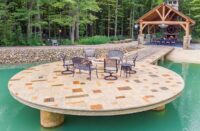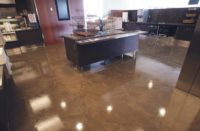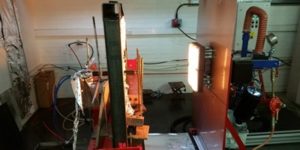In decorative concrete, a common question is, “Is it form before function, or function before form?” This question is more complex now — despite the answer, consumers ask if the construction materials used are sustainable. Is there such a thing as a low-carbon swimming pool, a low-carbon countertop or an environmentally friendly polished concrete floor?
People are becoming increasingly aware of how human activities impact the environment. For instance, some are already altering their eating habits or their travel patterns to minimize their carbon footprint and live a more sustainable lifestyle.
Construction materials and greenhouse gases
Construction materials are no exception to this trend that’s here to stay. In particular, the impact of construction materials on the emissions of greenhouse gases such as carbon dioxide is becoming a sensitive issue for people.
Few realize that portland cement is a poorly sustainable material. Its manufacturing requires burning limestone and other raw materials in a kiln at elevated temperatures using fossil fuels. As a result, estimates are that burning one ton of portland cement causes the release of one ton of carbon dioxide into the atmosphere. The manufacture of portland cement is responsible for approximately 5 percent of human CO2 emissions per year. This is a growing concern to the general public.
The science behind portland cement is based on Joseph Aspdin’s original patent in 1824, which makes this technology almost 200 years old. Few transformational or alternative technologies have emerged since then. However, some countries have already imposed a carbon tax on the manufacture of portland cement, which is forcing cement manufacturers to look at low-carbon alternatives to this technology.
For the most part, more sustainable concrete options have traditionally been limited to reducing the cement content in mortars and concrete, for example by adding noncarbon-emitting fillers such as limestone or fly ash. Yet this doesn’t reduce the carbon emissions of the cement at the plant.
Benefits of a new cement
A new cement with a lower carbon footprint is now available on the market. This cement, called belitic calcium sulfoaluminate (BCSA), is based on a completely different chemistry and is a radical departure from the Aspdin chemistry. Calcium sulfoaluminate (CSA) is the active compound in this cement.
Unlike portland cement, which requires the formation of tricalcium silicate (alite) at temperatures in excess of 1,450 degrees C, the CSA forms at 1,280 degrees C and doesn’t contain any alite. This drastically reduces the energy required to manufacture the CSA cement, as well the amount of limestone required as a raw material. As a result, CSA cement’s carbon footprint at the plant is roughly 67 percent of portland cement’s carbon footprint. BCSA cement doesn’t contain any portland cement.
An additional benefit of BCSA cement is that it sets and hardens much more rapidly than portland cement. While portland cement sets in approximately three hours, BCSA cement develops structural strength in less than one hour. This is due to the chemical differences in the hydration of the cement, compared to portland.
BCSA and Calcium Sulfate
Simply speaking, this hardening involves the reaction between BCSA and calcium sulfate in the cement to form ettringite crystals that very quickly develop while absorbing water and intertwining to add strength. This chemical reaction is fundamentally different from the chemical reactions causing the hardening process in portland cement concrete.
This rapid chemical reaction drastically increases a contractor’s efficiency on a job and shortens construction time. This type of concrete has now been used worldwide in large construction projects where construction speed is a requirement, such as in 1,000 lane-miles of highway construction in California.
A third benefit of BCSA cement concrete is that it shrinks less. This lowers the material’s propensity to crack, which increases its durability and sustainability. If a construction material doesn’t crack, it lasts longer.
Make an educated choice
Architects and contractors are increasing aware of the availability of this more sustainable alternative to portland cement. Since many bagged cementitious products are available, they can make an educated choice of the construction materials they use.
Several cement manufacturers offer bagged products that contain CSA, which are generally labelled as an ingredient on the bag. These products range from rapid-setting mortars for general repair work to self-leveling flooring materials. A wide range of binders are now commercially available.
Because CSA can be mixed with portland cement, it’s important for architects and contractors to find out how much CSA the product contains. Typically, the higher the CSA amount, the lower the carbon footprint. Typically, BCSA-containing products contain no portland cement and are a more sustainable option than materials containing portland cement.
Some retailers make it easier for construction professionals to understand the environmental impact of the products they’re looking to specify or use. Home Depot, for example, offers several more sustainable construction materials as part of its Eco Option program. This program requires the material to go through a review process. To certify that, the material is a more sustainable alternative to other options. Some CSA-based products are part of this program.
CSA cements can typically yield additional LEED points if the cement is made with recycled aluminum, synthetic anhydrite. Because BCSA is lighter in color, the concrete also lowers the heat island effect. Or it may contribute to urban heat effect associated with darker concrete like portland cement concrete.
This is the time for an innovative, more sustainable solution for decorative concrete in concrete construction materials. It is now up to the architects and contractors to assess these options for building a more sustainable world.
www.ctscement.com
















